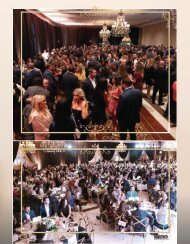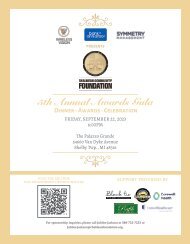AUGUST 2005
Create successful ePaper yourself
Turn your PDF publications into a flip-book with our unique Google optimized e-Paper software.
the DOCTOR is in<br />
Watch that sun as summer continues<br />
We’re in the dog days<br />
of August and<br />
everyone is enjoying<br />
outdoor activities.<br />
However, it’s important not to<br />
underestimate the damage<br />
that a hot and sunny day can<br />
cause. The dangers include<br />
dehydration and sunburn,<br />
oftentimes occurring without<br />
one realizing how badly they’re<br />
affected until it’s too late.<br />
Symptoms of dehydration<br />
include: dry skin, fatigue, light headedness,<br />
dizziness, confusion, dry mouth,<br />
muscle cramping, rapid heartbeat and,<br />
in the worst cases, heat stroke — a<br />
life-threatening emergency. Not needing<br />
to urinate or passing very dark yellow<br />
urine is a danger sign.<br />
Short-term results of unprotected<br />
UV (ultraviolet) radiation exposure<br />
include severe sunburn and tanning.<br />
Long-term exposure can cause prematurely<br />
aged skin, wrinkles, dark patches<br />
(“age or liver spots”), scaly patches<br />
DR. ADIL<br />
ARABBO<br />
COLUMNIST<br />
and can ultimately result in skin<br />
cancer, which is diagnosed in<br />
about 50,000 people each year<br />
and causes several thousand<br />
deaths.<br />
By taking the following simple<br />
precautions while outdoors,<br />
dehydration and skin damage<br />
can be easily avoided.<br />
• Limit direct sun exposure<br />
during midday: Ultraviolet rays<br />
are most intense when the sun<br />
is high in the sky, usually<br />
between the hours of 10 a.m. and 4<br />
p.m. If your shadow is shorter than<br />
you, the sun’s rays are the strongest<br />
and you should plan activities out of the<br />
sun during these times.<br />
• Cover up: Wear clothing to protect<br />
as much skin as possible. Longsleeved<br />
shirts, long pants or long skirts<br />
are the most protective. Dark colors<br />
provide more skin protection from UV<br />
rays than light colors. Always use hats,<br />
clothing and shading to protect babies<br />
younger than 6 months from the sun.<br />
• Wear a hat: A hat with at least a<br />
2- to 3-inch brim all around is ideal<br />
because it protects areas often<br />
exposed to the sun, such as the neck,<br />
ears, eyes, forehead, nose and scalp.<br />
A baseball cap provides protection for<br />
the front and top of the head but not<br />
the back of the neck or the ears, where<br />
skin cancer commonly develops.<br />
• Use a sunscreen with an SPF of<br />
15 or higher: Sunscreen products<br />
labeled “broad-spectrum” protect<br />
against UVA and UVB rays. Experts recommend<br />
products with an SPF (Skin<br />
Protection Factor) of at least 15. The<br />
number of the SPF represents the level<br />
of sunburn protection provided by the<br />
sunscreen. An SPF of 4 blocks out 75<br />
percent of the burning UV rays, while an<br />
SPF 15 blocks out 93 percent of the<br />
burning UV rays, and an SPF 30 blocks<br />
out 97 percent of the burning UV rays.<br />
Products labeled “waterproof” provide<br />
protection for at least 80 minutes, even<br />
when swimming or sweating, whereas<br />
products that are “water resistant” may<br />
provide protection for only 40 minutes.<br />
For children 6 months to 2 years, use a<br />
sunscreen with at least an SPF 15.<br />
• Be sure to apply the sunscreen<br />
properly: For maximum effectiveness,<br />
apply sunscreen 20 to 30 minutes<br />
before going outside. Be generous.<br />
Approximately one ounce of sunscreen<br />
should be used to cover the arms,<br />
legs, neck and face of the average<br />
adult. Less is needed for a child. For<br />
best results, most sunscreens need to<br />
be reapplied every 2 hours. If swimming<br />
or perspiring, don’t forget to<br />
reapply sunscreen to maintain protection<br />
and remember that sunscreen usually<br />
rubs off when you towel yourself<br />
dry. Use a lip balm that has a sunscreen<br />
component, as well.<br />
• Wear sunglasses that block UV<br />
rays: Your sunglasses should block 99<br />
to 100 percent of UVA and UVB radiation<br />
if the label on the glasses indicates<br />
“UV absorption up to 400 nm.”<br />
• Stay Hydrated: Prevent and treat<br />
dehydration by drinking plenty of water<br />
— the beverage of choice. Avoid caffeine,<br />
alcohol, sweetened beverages<br />
and sodas, which defeat the purpose of<br />
hydrating yourself by acting as diuretics.<br />
Carry a water bottle and drink plenty<br />
of water when outdoors, particularly<br />
if you are playing sports.<br />
Dr. Adil Arabbo is board certified in<br />
Family Medicine and has a private<br />
practice in Commerce. Visit<br />
www.advancedfamilycare.com.<br />
W H A<br />
T C A<br />
BASEBALL<br />
TEACH US ABOUT<br />
INVESTING?<br />
N<br />
A good coach can improve the results<br />
The Emrick Investment Group<br />
of Wachovia Securities<br />
Robert Stephens<br />
First Vice President – Investments<br />
Ron Emrick<br />
First Vice President – Investments<br />
255 E. Brown Street<br />
Birmingham, MI 48009<br />
248-433-8588 • 800-521-9463<br />
Uncommon Wisdom<br />
Wachovia Securities, LLC, member NYSE & SIPC. ©<strong>2005</strong> Wachovia Securities, LLC 62197 5/05<br />
44 CHALDEAN NEWS <strong>AUGUST</strong> <strong>2005</strong>

















